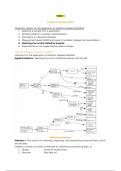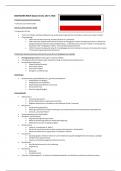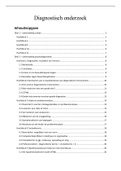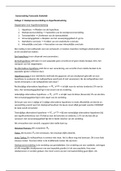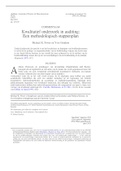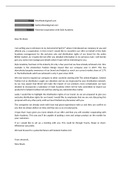Agency & Authority
Step 1 – Background
o In what circumstances are decisions taken by persons treated as decisions of the company? When the do
the acts of (human) directors or employees bind the (inanimate) company to obligations to third parties,
and does the company have the capacity to bound?
o Contractual liability – the power of a company to enter into a transaction is limited in two ways:
o 1. Capacity – was the act within the power of the company?
(i) Necessary to check the ‘objects clause’ in the memorandum to check which acts/business, the
company is empowered to participate in.
(ii) If the transaction is outside the company’s powers, it is consequently void and unenforceable
(ultra vires) against the company even if the shareholders attempted to ratify the act. This is
because the company was not incorporated with the requisite capacity (Ashbury v Richie).
(iii) *Capacity not as relevant to companies incorporated under CA 2006, because the
memorandum no longer contains an object clause – under s31 CA 2006, a company’s objects
are unrestricted (subject to its articles)
(iv) But may encounter companies incorporated under previous Companies Acts which may have
their capacity restricted by their objects clauses.
o 2. Authority – If a company DOES have capacity, must ask whether the individual who contracted on the
company’s behalf had the authority to do so. If yes, then the transaction is valid, but if not, the transaction
is voidable at the instance of the company.
o Doctrine of Ultra Vires? Companies are not allowed to act outside of their object’s clause, and if they did
was vulnerable to being wound up by the court (German Date Coffee).
o Problems? Objects clause was originally not permitted to be altered. Later legislation allowed alteration but
only in very limited circumstances until 1991, when amendments to CA 1985 came into force.
o (i) Inhibits diversification – companies often diversify and change their business, which is often key to
business to protect their future.
o Reform of Ultra vires? CA 1985 (amendments in 1991) introduced changes – introduction of a provision in
s35 CA 1985 removing the doctrine of constructive notice in relation to company’s memorandum &
articles.
o CA 2006 Reforms: enshrined the above changes in s39(1): ‘’the validly of an act done by a company shall
not be called into question on the grounds of lack of capacity by reason of anything in the company’s
constitution. Also (i) requirement for an objects clause in the memorandum was completely removed. (ii)
s31 states that the default position is now that all companies have unrestricted objects (but can still
choose to insert one if they wish).
o Companies formed prior to CA 2006: Objects clauses are treated as a provision of the articles (s28(1)) and
will continue to bind the company unless altered by special resolution. If a company adopts new articles
then this treats the objects clause as being removed. *It is therefore necessary to check the position but any
issues of Ultra Vires are rare.
**Step 2**: Agency and Authority
o An agent is appointed by a principal to act on their behalf – the contract will be entered into between the
principle and the third party, not the agent, who merely represents the principle.
o In order to validly represent the principal an agent needs authority – this can be 1. actual (a) express or
(b) implied) or 2. deemed (either at (a)statute, or at (b) common law - ostensible or ‘apparent’ authority
or at (c) common law under the indoor management rule in Turquand’s case.
o 1. ACTUAL AUTHORITY – The actual authority of an agent is the authority that has been actually
conferred on them by the principal. (Freeman and Lockyer – Diplock J ‘actual authority is a legal
relationship between the principle and agent created by a consensual agreement to which they alone are
parties.’’
o (a) Express Authority (actual)– A company’s articles gives the board of directors’ express general authority
to manage the business of the company. MA 3 states that ‘’subject to the articles, the directors are
responsible for the management of the company’s business, for which purpose they may exercise all the
powers of the company.’’ MA 5 & 6 also give the directors the authority to delegate any of their powers to
others.
,o (b) implied Authority (actual) arising – (i) from appointment to a specific role in the company – e.g. a
manager can be given a specific job description by the board but often much of the actual authority is
implied by the position held and by the custom in the company or industry, so in Smith v Butler was held
that the implied powers of a MD are those that would ordinarily be exercisable by a MD in his position,
subject to the company’s articles and anything parties expressly agreed. (ii) from a course of dealing:
Actual authority can be implied from a course of dealing, for example where a director or other agent
continually enters into specific transactions and the board of directors either acquiesces or agrees to this.
(Helly Hutchinson v Brayhead – despite having no express authority, court held that he had implied actual
authority from a course of dealing due to his conduct over many months of entering into similar contracts
and later notifying the board, who never objected.
o *Implied actual authority can be distinguished from ostensible or apparent authority as with implied actual
authority, it is only the relationship between the principal and the agent which is relevant to determining
whether implied actual authority exists.
o 2. DEEMED AUTHORITY – Refers to the situation where an agent has no actual authority yet can still bind
the principal. *Means that third parties acting in good faith are entitled to assume the directors’ powers
are free of any constitutional limitations.
o (a) Deemed authority under s 40 CA 2006. 40(1) provides that ‘’In favour of a person dealing with a
company in good faith, the power of the directors to bind the company, or authorise others to do so, is
deemed to be free of any limitation under the company’s constitution. (2) For this purpose (a) a person
‘’deals with’’ a company if he is party to any transaction or other act to which the company is a party (b) a
person dealing with a company – (i) is not bound to enquire as to any limitation on the powers of directors
to bind the company or authorise others to do so, (ii) is presumed to have acted in good faith unless the
contrary is proved, and (iii) is not to be regarded in bad faith by reason only of his knowing that an act is
beyond the powers of the directors under the company’s constitution. 40(3) limitations include (a) from a
resolution of the company or of any class of shareholders, or (b) from any agreement between the members
of the company or of any class of shareholders.
o So, this means that the company cannot claim not to be bound by the acts of its directors by asserting
these acts to have been unconstitutional – this applies even when the articles require specific
shareholder/approval for a particular act. The threshold for proving a third party acted in bad faith is high.
And this only protects third parties, not directors – if a director acts ultra vires the company can sue
them and recover compensation for any consequential losses caused.
o (b) Ostensible (apparent) authority under common law – Actual authority arises from the relationship
between principal and agent. In contrast, ostensible or apparent authority is determined by looking at the
relationship between the principle and the third party. Ostensible authority refers to the authority of an
agent as it appears to a third party. It arises where, rather than any actual authority being given, the board
of directors or the general meeting allows someone to hold themselves out as having such authority or
allowing someone to hold themselves out as having a position in the company that would have such
authority Freeman & Lockyer v Buckhurst Park [1964] – AC upheld claim on basis of ostensible authority:
although K had no actual authority, the board had held K out as the MD, allowing him to act in this way,
and therefore K has ostensible authority to bind the company.
o (c) Indoor Management rule in Turquand’s case – less significant now due to s40 CA 2006, but still applies
in certain situations: in particular where the third party has not dealt directly with the board, or a question
of whether the agent was authorised by the board arises. The principle is that outsiders are entitled to
assume that the company’s internal procedures have been complied with (known as the ‘indoor
management rule’).
o ^Note: This rule will not apply where the third party has actual notice of the irregularity, is not acting in
good faith, or where the third party is an insider (e.g. directors’ contract with a company).
o Ratification – company is able to ratify acts that are beyond the actual authority of its agents, provided
that the act is within the authority of the appropriate organ of the company who are looking to ratify it
(board or shareholders). Ratification involved passing a resolution to approve the act and agree the
company will be bound by it. New Falmouth Resorts v International Hotels Jamaica – court stated ‘’the acts
of an agent on behalf of the principal outside his actual authority may be adopted and ratified’’ (and) ‘’if
there is ratification it has retrospective effect.
,Step 3: Pre-incorporation contracts
o A company comes into existence at the time of issue of the certificate of incorporation by the Registrar of
Companies (s 15 CA 2006) Until then it is not a legal person and therefore has no capacity to enter into
contracts (Rover International v Cannon Film Sales)
o If a contract was entered into before the company is incorporated, then as the company did not exist at
that point as a legal person, it is not possible for it have legal rights/obligations under the contract (did not
have legal capacity at that point). Therefore, an important issue arises as to who can be liable under a ‘’pre-
incorporation contract.’’
o S 51 CA 2006: This situation is not dealt with by 51 CA 2006. This seeks to protect third parties who believe
they are entering into a contract the company which is incorporated and registered by making pre-
incorporation contracts enforceable as person contracts against the persons purporting to act on the
company’s behalf (known as ‘’promoters’’). Thus, since there is no company to be privy to pre-
incorporation contracts, its promoters bear personal liability.
It is however necessary to look at the facts to determine whether there was an express agreement that
the signatory would not be personally bound by contract (Denning LJ in Phonogram v Lane)
(Hepburn v Revenue & Customs court held that ‘’subject to any agreement to the contrary’’ proviso
applied here as there was never any intention on anyone’s part that the appellant should become
personally entitled to fees.
o Ratification of Pre-incorporation Contracts – only possible for acts which a company could have authorised
at the time, and thus given the company did not exist when the contract was formed it could not have
authorised an agent to act on its behalf & so cannot retrospectively ratify (Kelner v Baxter)
Novation – the only way a company can obtain the benefit of a contract purportedly made on its
behalf before it came into existence is to novate the contract (Natal Land co). This is when
company, and other party substitute the pre-incorporation contract with a new contract on similar
terms.
Shelf company – When formed on this basis a company can enter into contract because it already
has a legal personality even though the names & details will be changed. (Oshkosh).
o Liability of Agent or Promoter: agents are personally liable under s51 but can also enforce the benefits of
the contract (Braymist v Wise Finance) Usual rules of contract will apply.
Step 4: Liability in tort and crime
There are two ways in which a company may be held liable in Tort (in general vicarious liability will not
attribute criminal liability for the act of an employee).
o 1. Primary liability: Where the company itself is said to have committed the tort through the acts of an
individual which are attributed to the company.
The attribution theory: This theory requires a particular individual within a corporate organisational
structure to be identified as the ‘’controlling’ and ‘guiding’ mind and the difficult is this was not
always possible. (Tesco Supermarkets v Nattrass – courts found that the manager was not the
‘guiding mind’ and therefore Tesco could not be liable for his actions).
However, in Meridan Global Funds Management Asia Ltd v Securities Commission Lord Hoffman
considered that the organic theory provided a misleading analysis. The real issues were who were
the controllers of the company for the purposes of attribution rather than searching for the ‘guiding
mind’ of the company, which made liability easier to establish. In this case the controllers on the
facts were found to be senior managers and the company was accordingly liable. This case allowed
the attribution of liability to the company for the acts of individuals lower down the organisational
structure.
Corporate Manslaughter and Corporate Homicide Act 2007 – enacted a specific statutory offence of
corporate manslaughter to enable companies to be found liable for manslaughter in relevant
circumstances (even post meridian, criminal liability for companies was still difficult to establish).
‘’The offence is committed by the company if the manner in which its activities are managed or
organised by its senior management causes the death of a person and amounts to a gross breach
(i.e. the conduct fell far below what can be reasonably expected of the organisation in the
, circumstances) of the relevant duty of care owed to the person If found guilty, the company may be
liable to pay a fine.
The first conviction under this act was R v Costwold Geotechnical Holdings Ltd where the company
was fined £385,000 in relation to the death of an employee who had entered an unsupported pit
during the course of his work.
o 2. Vicarious liability: an individual within the company is personally liable for the tort, BUT the company is
additionally vicariously liable for that person’s act or omission (both JOINTLY liable). Company itself is not
at fault (incurs ‘strict liability’, but is legally responsible for the tortious acts of its employee.
Directors and their duties
o Director’s manage the company on a day-to-day basis.
o 157 CA – a person may not be appointed as a director unless they are at least 16 years old.
o Power derives from MA 3: ‘’Subject to the articles, directors are responsible for management of the
company’s business, for which purpose they may exercise all the powers of the company.’’ S 154 CA:
Private limited company must have at least one director, every company must have one director who is a
natural person. S167 – person appointed to act as a director has consented to act as one.
o Shareholders powers: MA 4: ‘’Shareholders may by special resolution, direct the directors to take, or
refrain from taking specified action’’ & s168: Shareholders can remove director by ordinary resolution. 169
where such a resolution is proposed, the director has the right to be heard at the GM and therefore written
resolutions cannot be used.
o Different types: (i) De jure – validly appointed at law (ii) Shadow – assumes to act as a director but has in
fact not been validly appointed. Shadow (s 251 (i)) – ‘’person in accordance with whose directions or
instructions the directors or the company are accustomed to act’’ – controls the company’s affairs and
board (Hydrodam (Corby) Ltd), Executive – both an officer & employee of his company, Non-exec director –
independent guidance and advice to the board & protects shareholder’s interests.
o Appointment: MA 17(1): ‘’Any person who is willing to act as a director, and is permitted by law to do so,
may be appointed to be director; (a) by ordinary resolution (b) by a decision of the directors.
o MA 19– Terms of an individual director’s service contract, including remuneration, are for the board to
determine. MA 18 provides that a director is automatically deemed to vacate office where that person
becomes prohibited from being a director, bankrupt, subject to a composition order made with creditors,
or physically or mentally incapable for more than three months.
o Bushell v Faith clause – give weighted voting rights allowing directors/shareholders to block resolutions to
sack director (s 168) who is also a shareholder.
Step 2 - Disqualification
o Company Directors Disqualification Act 1986 (CDDA 1986) allows directors to be disqualified in certain
circumstances.
o Two types of disqualification order:
o (i) Mandatory (2 – 15 years) made under s6(1) CDDA 1986 where court is satisfied (a) The he is or has been
director of company which has at any time become insolvent (b) His conduct as director of that company
makes him unfit to be concerned in the management of the company. Section 6 has been taken to mean
essentially that the director has abused privilege of limited liability is some way, either by gross negligence
or deliberate disregard for creditors’ interests.
o (ii) Discretionary disqualification orders (up to 10 years), grounds: s2 CDDA 86: Conviction of an indicatable
offence in connection with the management of the company property, s3: Persistent breaches of company
legislation requiring returns or notices to be given to the registrar. S4 Fraud: either fraudulent trading
under s 993 CA 2006, wrongful trading under s 213 and s 214 Insolvency Act 1986 or fraud in relation to the
company or its property. S8: Disqualification after investigation of the company – used where it seems to
the SoS it would be in public interest for a disqualification order to be made, SoS for Business, Innovation
and Skills v Pawson.
o Criminal penalties – it is a criminal offence to act in contravention of a disqualification order and any
person doing so is liable for fine and imprisonment or both (s 13), as well as being personally liable for all
Step 1 – Background
o In what circumstances are decisions taken by persons treated as decisions of the company? When the do
the acts of (human) directors or employees bind the (inanimate) company to obligations to third parties,
and does the company have the capacity to bound?
o Contractual liability – the power of a company to enter into a transaction is limited in two ways:
o 1. Capacity – was the act within the power of the company?
(i) Necessary to check the ‘objects clause’ in the memorandum to check which acts/business, the
company is empowered to participate in.
(ii) If the transaction is outside the company’s powers, it is consequently void and unenforceable
(ultra vires) against the company even if the shareholders attempted to ratify the act. This is
because the company was not incorporated with the requisite capacity (Ashbury v Richie).
(iii) *Capacity not as relevant to companies incorporated under CA 2006, because the
memorandum no longer contains an object clause – under s31 CA 2006, a company’s objects
are unrestricted (subject to its articles)
(iv) But may encounter companies incorporated under previous Companies Acts which may have
their capacity restricted by their objects clauses.
o 2. Authority – If a company DOES have capacity, must ask whether the individual who contracted on the
company’s behalf had the authority to do so. If yes, then the transaction is valid, but if not, the transaction
is voidable at the instance of the company.
o Doctrine of Ultra Vires? Companies are not allowed to act outside of their object’s clause, and if they did
was vulnerable to being wound up by the court (German Date Coffee).
o Problems? Objects clause was originally not permitted to be altered. Later legislation allowed alteration but
only in very limited circumstances until 1991, when amendments to CA 1985 came into force.
o (i) Inhibits diversification – companies often diversify and change their business, which is often key to
business to protect their future.
o Reform of Ultra vires? CA 1985 (amendments in 1991) introduced changes – introduction of a provision in
s35 CA 1985 removing the doctrine of constructive notice in relation to company’s memorandum &
articles.
o CA 2006 Reforms: enshrined the above changes in s39(1): ‘’the validly of an act done by a company shall
not be called into question on the grounds of lack of capacity by reason of anything in the company’s
constitution. Also (i) requirement for an objects clause in the memorandum was completely removed. (ii)
s31 states that the default position is now that all companies have unrestricted objects (but can still
choose to insert one if they wish).
o Companies formed prior to CA 2006: Objects clauses are treated as a provision of the articles (s28(1)) and
will continue to bind the company unless altered by special resolution. If a company adopts new articles
then this treats the objects clause as being removed. *It is therefore necessary to check the position but any
issues of Ultra Vires are rare.
**Step 2**: Agency and Authority
o An agent is appointed by a principal to act on their behalf – the contract will be entered into between the
principle and the third party, not the agent, who merely represents the principle.
o In order to validly represent the principal an agent needs authority – this can be 1. actual (a) express or
(b) implied) or 2. deemed (either at (a)statute, or at (b) common law - ostensible or ‘apparent’ authority
or at (c) common law under the indoor management rule in Turquand’s case.
o 1. ACTUAL AUTHORITY – The actual authority of an agent is the authority that has been actually
conferred on them by the principal. (Freeman and Lockyer – Diplock J ‘actual authority is a legal
relationship between the principle and agent created by a consensual agreement to which they alone are
parties.’’
o (a) Express Authority (actual)– A company’s articles gives the board of directors’ express general authority
to manage the business of the company. MA 3 states that ‘’subject to the articles, the directors are
responsible for the management of the company’s business, for which purpose they may exercise all the
powers of the company.’’ MA 5 & 6 also give the directors the authority to delegate any of their powers to
others.
,o (b) implied Authority (actual) arising – (i) from appointment to a specific role in the company – e.g. a
manager can be given a specific job description by the board but often much of the actual authority is
implied by the position held and by the custom in the company or industry, so in Smith v Butler was held
that the implied powers of a MD are those that would ordinarily be exercisable by a MD in his position,
subject to the company’s articles and anything parties expressly agreed. (ii) from a course of dealing:
Actual authority can be implied from a course of dealing, for example where a director or other agent
continually enters into specific transactions and the board of directors either acquiesces or agrees to this.
(Helly Hutchinson v Brayhead – despite having no express authority, court held that he had implied actual
authority from a course of dealing due to his conduct over many months of entering into similar contracts
and later notifying the board, who never objected.
o *Implied actual authority can be distinguished from ostensible or apparent authority as with implied actual
authority, it is only the relationship between the principal and the agent which is relevant to determining
whether implied actual authority exists.
o 2. DEEMED AUTHORITY – Refers to the situation where an agent has no actual authority yet can still bind
the principal. *Means that third parties acting in good faith are entitled to assume the directors’ powers
are free of any constitutional limitations.
o (a) Deemed authority under s 40 CA 2006. 40(1) provides that ‘’In favour of a person dealing with a
company in good faith, the power of the directors to bind the company, or authorise others to do so, is
deemed to be free of any limitation under the company’s constitution. (2) For this purpose (a) a person
‘’deals with’’ a company if he is party to any transaction or other act to which the company is a party (b) a
person dealing with a company – (i) is not bound to enquire as to any limitation on the powers of directors
to bind the company or authorise others to do so, (ii) is presumed to have acted in good faith unless the
contrary is proved, and (iii) is not to be regarded in bad faith by reason only of his knowing that an act is
beyond the powers of the directors under the company’s constitution. 40(3) limitations include (a) from a
resolution of the company or of any class of shareholders, or (b) from any agreement between the members
of the company or of any class of shareholders.
o So, this means that the company cannot claim not to be bound by the acts of its directors by asserting
these acts to have been unconstitutional – this applies even when the articles require specific
shareholder/approval for a particular act. The threshold for proving a third party acted in bad faith is high.
And this only protects third parties, not directors – if a director acts ultra vires the company can sue
them and recover compensation for any consequential losses caused.
o (b) Ostensible (apparent) authority under common law – Actual authority arises from the relationship
between principal and agent. In contrast, ostensible or apparent authority is determined by looking at the
relationship between the principle and the third party. Ostensible authority refers to the authority of an
agent as it appears to a third party. It arises where, rather than any actual authority being given, the board
of directors or the general meeting allows someone to hold themselves out as having such authority or
allowing someone to hold themselves out as having a position in the company that would have such
authority Freeman & Lockyer v Buckhurst Park [1964] – AC upheld claim on basis of ostensible authority:
although K had no actual authority, the board had held K out as the MD, allowing him to act in this way,
and therefore K has ostensible authority to bind the company.
o (c) Indoor Management rule in Turquand’s case – less significant now due to s40 CA 2006, but still applies
in certain situations: in particular where the third party has not dealt directly with the board, or a question
of whether the agent was authorised by the board arises. The principle is that outsiders are entitled to
assume that the company’s internal procedures have been complied with (known as the ‘indoor
management rule’).
o ^Note: This rule will not apply where the third party has actual notice of the irregularity, is not acting in
good faith, or where the third party is an insider (e.g. directors’ contract with a company).
o Ratification – company is able to ratify acts that are beyond the actual authority of its agents, provided
that the act is within the authority of the appropriate organ of the company who are looking to ratify it
(board or shareholders). Ratification involved passing a resolution to approve the act and agree the
company will be bound by it. New Falmouth Resorts v International Hotels Jamaica – court stated ‘’the acts
of an agent on behalf of the principal outside his actual authority may be adopted and ratified’’ (and) ‘’if
there is ratification it has retrospective effect.
,Step 3: Pre-incorporation contracts
o A company comes into existence at the time of issue of the certificate of incorporation by the Registrar of
Companies (s 15 CA 2006) Until then it is not a legal person and therefore has no capacity to enter into
contracts (Rover International v Cannon Film Sales)
o If a contract was entered into before the company is incorporated, then as the company did not exist at
that point as a legal person, it is not possible for it have legal rights/obligations under the contract (did not
have legal capacity at that point). Therefore, an important issue arises as to who can be liable under a ‘’pre-
incorporation contract.’’
o S 51 CA 2006: This situation is not dealt with by 51 CA 2006. This seeks to protect third parties who believe
they are entering into a contract the company which is incorporated and registered by making pre-
incorporation contracts enforceable as person contracts against the persons purporting to act on the
company’s behalf (known as ‘’promoters’’). Thus, since there is no company to be privy to pre-
incorporation contracts, its promoters bear personal liability.
It is however necessary to look at the facts to determine whether there was an express agreement that
the signatory would not be personally bound by contract (Denning LJ in Phonogram v Lane)
(Hepburn v Revenue & Customs court held that ‘’subject to any agreement to the contrary’’ proviso
applied here as there was never any intention on anyone’s part that the appellant should become
personally entitled to fees.
o Ratification of Pre-incorporation Contracts – only possible for acts which a company could have authorised
at the time, and thus given the company did not exist when the contract was formed it could not have
authorised an agent to act on its behalf & so cannot retrospectively ratify (Kelner v Baxter)
Novation – the only way a company can obtain the benefit of a contract purportedly made on its
behalf before it came into existence is to novate the contract (Natal Land co). This is when
company, and other party substitute the pre-incorporation contract with a new contract on similar
terms.
Shelf company – When formed on this basis a company can enter into contract because it already
has a legal personality even though the names & details will be changed. (Oshkosh).
o Liability of Agent or Promoter: agents are personally liable under s51 but can also enforce the benefits of
the contract (Braymist v Wise Finance) Usual rules of contract will apply.
Step 4: Liability in tort and crime
There are two ways in which a company may be held liable in Tort (in general vicarious liability will not
attribute criminal liability for the act of an employee).
o 1. Primary liability: Where the company itself is said to have committed the tort through the acts of an
individual which are attributed to the company.
The attribution theory: This theory requires a particular individual within a corporate organisational
structure to be identified as the ‘’controlling’ and ‘guiding’ mind and the difficult is this was not
always possible. (Tesco Supermarkets v Nattrass – courts found that the manager was not the
‘guiding mind’ and therefore Tesco could not be liable for his actions).
However, in Meridan Global Funds Management Asia Ltd v Securities Commission Lord Hoffman
considered that the organic theory provided a misleading analysis. The real issues were who were
the controllers of the company for the purposes of attribution rather than searching for the ‘guiding
mind’ of the company, which made liability easier to establish. In this case the controllers on the
facts were found to be senior managers and the company was accordingly liable. This case allowed
the attribution of liability to the company for the acts of individuals lower down the organisational
structure.
Corporate Manslaughter and Corporate Homicide Act 2007 – enacted a specific statutory offence of
corporate manslaughter to enable companies to be found liable for manslaughter in relevant
circumstances (even post meridian, criminal liability for companies was still difficult to establish).
‘’The offence is committed by the company if the manner in which its activities are managed or
organised by its senior management causes the death of a person and amounts to a gross breach
(i.e. the conduct fell far below what can be reasonably expected of the organisation in the
, circumstances) of the relevant duty of care owed to the person If found guilty, the company may be
liable to pay a fine.
The first conviction under this act was R v Costwold Geotechnical Holdings Ltd where the company
was fined £385,000 in relation to the death of an employee who had entered an unsupported pit
during the course of his work.
o 2. Vicarious liability: an individual within the company is personally liable for the tort, BUT the company is
additionally vicariously liable for that person’s act or omission (both JOINTLY liable). Company itself is not
at fault (incurs ‘strict liability’, but is legally responsible for the tortious acts of its employee.
Directors and their duties
o Director’s manage the company on a day-to-day basis.
o 157 CA – a person may not be appointed as a director unless they are at least 16 years old.
o Power derives from MA 3: ‘’Subject to the articles, directors are responsible for management of the
company’s business, for which purpose they may exercise all the powers of the company.’’ S 154 CA:
Private limited company must have at least one director, every company must have one director who is a
natural person. S167 – person appointed to act as a director has consented to act as one.
o Shareholders powers: MA 4: ‘’Shareholders may by special resolution, direct the directors to take, or
refrain from taking specified action’’ & s168: Shareholders can remove director by ordinary resolution. 169
where such a resolution is proposed, the director has the right to be heard at the GM and therefore written
resolutions cannot be used.
o Different types: (i) De jure – validly appointed at law (ii) Shadow – assumes to act as a director but has in
fact not been validly appointed. Shadow (s 251 (i)) – ‘’person in accordance with whose directions or
instructions the directors or the company are accustomed to act’’ – controls the company’s affairs and
board (Hydrodam (Corby) Ltd), Executive – both an officer & employee of his company, Non-exec director –
independent guidance and advice to the board & protects shareholder’s interests.
o Appointment: MA 17(1): ‘’Any person who is willing to act as a director, and is permitted by law to do so,
may be appointed to be director; (a) by ordinary resolution (b) by a decision of the directors.
o MA 19– Terms of an individual director’s service contract, including remuneration, are for the board to
determine. MA 18 provides that a director is automatically deemed to vacate office where that person
becomes prohibited from being a director, bankrupt, subject to a composition order made with creditors,
or physically or mentally incapable for more than three months.
o Bushell v Faith clause – give weighted voting rights allowing directors/shareholders to block resolutions to
sack director (s 168) who is also a shareholder.
Step 2 - Disqualification
o Company Directors Disqualification Act 1986 (CDDA 1986) allows directors to be disqualified in certain
circumstances.
o Two types of disqualification order:
o (i) Mandatory (2 – 15 years) made under s6(1) CDDA 1986 where court is satisfied (a) The he is or has been
director of company which has at any time become insolvent (b) His conduct as director of that company
makes him unfit to be concerned in the management of the company. Section 6 has been taken to mean
essentially that the director has abused privilege of limited liability is some way, either by gross negligence
or deliberate disregard for creditors’ interests.
o (ii) Discretionary disqualification orders (up to 10 years), grounds: s2 CDDA 86: Conviction of an indicatable
offence in connection with the management of the company property, s3: Persistent breaches of company
legislation requiring returns or notices to be given to the registrar. S4 Fraud: either fraudulent trading
under s 993 CA 2006, wrongful trading under s 213 and s 214 Insolvency Act 1986 or fraud in relation to the
company or its property. S8: Disqualification after investigation of the company – used where it seems to
the SoS it would be in public interest for a disqualification order to be made, SoS for Business, Innovation
and Skills v Pawson.
o Criminal penalties – it is a criminal offence to act in contravention of a disqualification order and any
person doing so is liable for fine and imprisonment or both (s 13), as well as being personally liable for all

